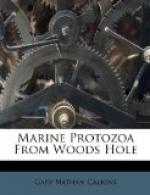Epiclintes radiosa Quenn. Fig. 50.
Synonym: Metra radiosa Quenn.
The body is elongate, slightly narrowed anteriorly, and drawn out posteriorly into a long, retractile, tail-like portion. Five large cirri extend outward from the anterior extremity. The caudal portion may be extended to a distance equal to twice the length of the body or contracted to half the length. The peculiar nervousness of this form made it extremely difficult to study, and the oral region was imperfectly made out. The anterior cirri appear to line the upper left border of the peristome, which is marked by a row of large cilia. The peristome begins upon the right side of the anterior end and passes backward and to the left, narrowing at this point. The mouth is very small and difficult to see. It is apt to stay in one locality under zoogloea, switching back and forth with great vivacity, or hanging on by the posterior cilia while the anterior end stretches out in the surrounding medium. Nucleus and contractile vacuole were not observed. Length 45 mu.
[Illustration: Fig. 50.—Epiclintes radiosa.]
Genus AMPHISIA Sterki ’78.
(Sterki ’78; Kent ’81; Buetschli ’88.)
The body is plastic and soft, colorless or slightly tinged with yellow or red. In form it is oval or elongate, the posterior end is rounded and slightly reduced in diameter, but does not form a distinct tail. The anterior end is also rounded and similarly reduced in width. There are two rows of marginal cirri (Randcirren), which may be placed some distance from the edge, and two or three rows of ventral cirri between them. There are from 3 to 5 frontal cirri of larger size than those of the ventral rows, and from 5 to 10 anal cirri. (The genus Holosticha is similar in all respects save the presence of frontal cirri.) The macronucleus is double; the contractile vacuole is central and on the left side. The peristome is long and rather narrow and carries an undulating membrane on its right margin. Fresh and salt water.
Amphisia kessleri Wrzes. ’77. Fig. 51.
Synonyms: Trichoda gibba Mueller; Oxytricha gibba Stein ’59; O. velox? Quen. ’69; O. kessleri Wrzes. ’77.
Body elongate, slightly sigmoid and swollen in the center, about 3-1/2 times as long as broad; the rounded anterior end is turned to the left, the similarly rounded posterior end to the right; both ends taper slightly. The peristome is long and narrow, with a distinct adoral zone which appears broken in its course. To the right of this adoral zone is a single line of preoral cilia. On the right border of the peristome is an undulating membrane. The three frontal cirri form a triangle and the five smaller anal cirri form a continuous line with the broken row of ventral cirri. There are two and one-half rows of ventral cirri and the marginal cirri are drawn in until they are ventral in position.




